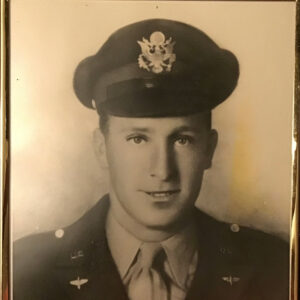calsfoundation@cals.org
Durden William Looper (1923–1945)
Durden William Looper was a twenty-two-year-old U.S. Army Air Corps pilot from Sebastian County who was one of several American prisoners of war who died in the August 6, 1945, atomic bombing of Hiroshima, Japan.
Durden Looper was born on March 18, 1923, the son of Walter and Bertha Looper. He grew up on the family farm near Greenwood (Sebastian County) and graduated from Mansfield High School in Mansfield (Sebastian and Scott counties) in 1939. He married Ruth Marie Kurtz in 1942, the same year he joined the Army Air Corps. They had one daughter, Virginia.
Second Lieutenant Looper was the co-pilot of the B-24 bomber Lonesome Lady when it took off from an airstrip on Okinawa on July 28, 1945, on a mission to destroy the damaged Japanese battleship Haruna in Kure Harbor near Hiroshima. The Lonesome Lady and another bomber in the formation, the Taola, were both damaged by anti-aircraft fire. Looper and all but one of his plane’s crew bailed out and were soon captured by Japanese soldiers.
The blindfolded captives were taken to the Chugoku military headquarters in Hiroshima, and the Lonesome Lady’s pilot, Thomas Cartwright, was soon transferred to Tokyo for further interrogation because he was the mission commander. At least ten Americans from the Lonesome Lady and the Taola, as well as a couple of U.S. Navy pilots, were held in three separate facilities in Hiroshima.
At 8:15 a.m. on August 6, 1945, a single bomber, the Enola Gay, flew over Hiroshima and dropped an atomic bomb that devastated the city. Estimates of Japanese casualties range from 70,000 to 140,000 dead, and all of the American prisoners either died in the blast or from radiation sickness afterward. The Chugoku building where Looper was held, located about 2,600 feet from where the bomb detonated, was extensively damaged, with two wooden wings burned to the ground.
World War II ended when Japan surrendered after a second atomic bomb was dropped on Nagasaki, Japan, on August 9, 1945. Ruth Looper was told six months later that her husband “probably died” in the atomic explosion at Hiroshima. (Department of Defense officials apparently never officially confirmed that the deaths of the Americans were caused by the atomic blast, in part because a massive amount of service records were lost in a 1973 fire in St. Louis, Missouri.)
A mass funeral was held at Jefferson Barracks National Cemetery near St. Louis on November 3, 1949, where a single coffin was buried in Section 82, Site 156, with a stone listing Looper and seven other soldiers, all but one with a death date of August 6, 1945. A bronze plaque honoring Looper and eight other American casualties at Hiroshima was dedicated on August 5, 1989, at Andersonville National Historic Site in Georgia, where the National Park Service interprets the experiences of American prisoners of war.
For additional information:
“2LT Durden William Looper.” Find a Grave. https://www.findagrave.com/memorial/32720454/durden-william-looper (accessed April 19, 2024).
“Arkansan Who Died in Hiroshima Blast and Others to Be Honored.” Baxter Bulletin, July 31, 1989, p. 7.
“Arkansas Pilot Killed by Hiroshima A-Bomb.” Arkansas Gazette, August 6, 1977, p. 4A.
“Information on Arkansas POW Flows to Researcher, Once Hometown Found.” Baxter Bulletin, August 9, 1989, p. 9.
Bowles, Scott. “Arkansan’s Life No Longer a Mystery.” Arkansas Gazette, August 8, 1989, pp. 1A, 7A.
Hudson, Repps B. “Did B-24 Crew Die in A-Blast?” Kansas City [Missouri] Times, November 20, 1975, pp. 1A, 10C.
Manoff, Robert Karl. “8 [sic] American POWs Died When U.S. Bombed Hiroshima.” Arkansas Gazette, December 2, 1984, pp. 1H, 4H.
Thomas, Gordon, and Max Morgan Witts. Enola Gay. New York: Stine and Day, 1977.
Wellerstein, Alex. “Counting the Dead at Hiroshima and Nagasaki.” Bulletin of the Atomic Scientists, August 4, 2020. https://thebulletin.org/2020/08/counting-the-dead-at-hiroshima-and-nagasaki/ (accessed April 19, 2024).
Mark K. Christ
Central Arkansas Library System
 Military
Military World War II through the Faubus Era, 1941 through 1967
World War II through the Faubus Era, 1941 through 1967 William Durden Looper
William Durden Looper 




Comments
No comments on this entry yet.